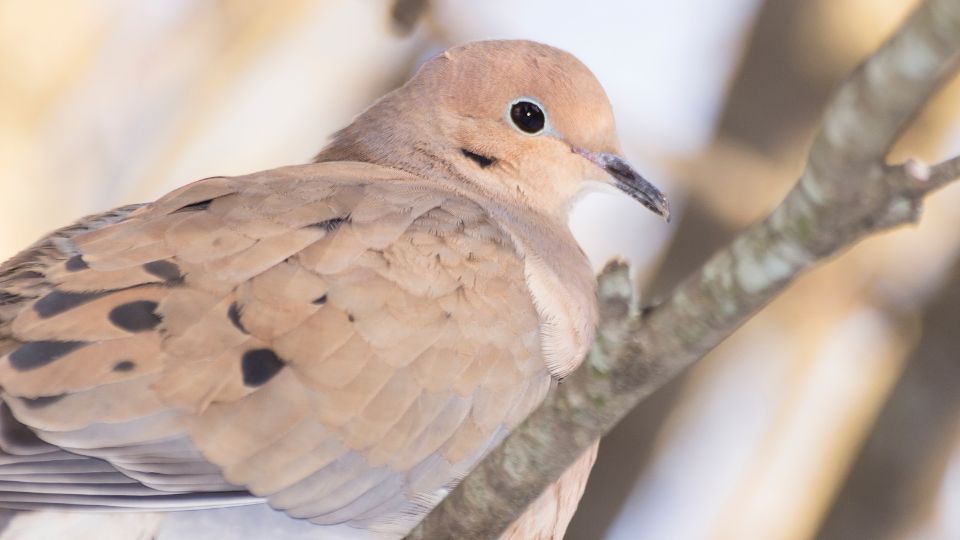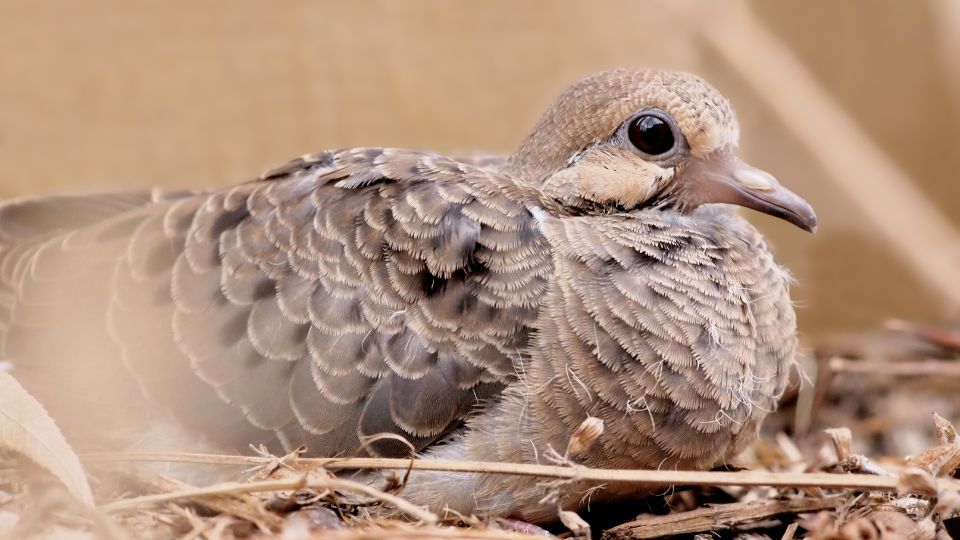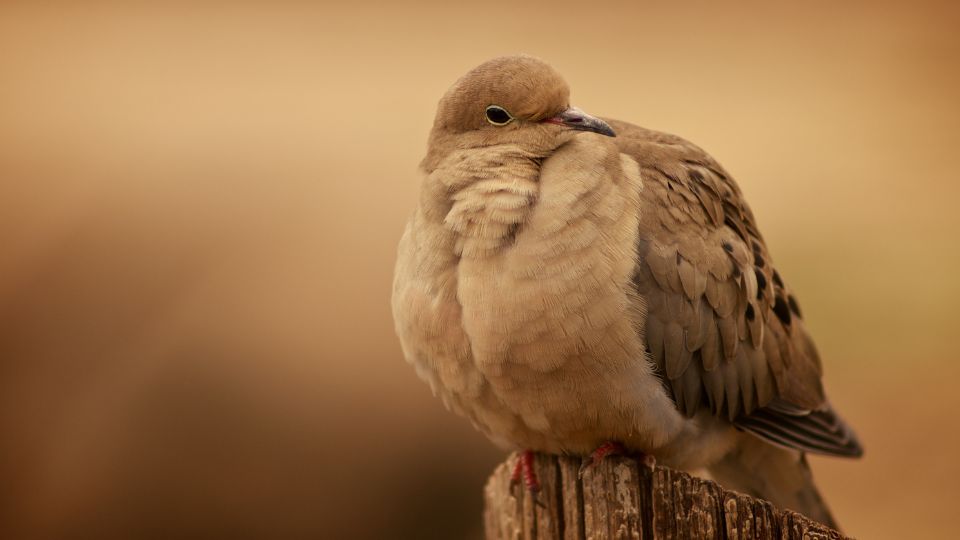Mourning doves can be found sleeping out of sight of predators. Areas like high tree branches, nest boxes, eaves, covered porches, and chimneys are prime roosting spots.
Doves can nest in dead and living trees, but they prefer trees on the edge of open fields. This provides a better line of sight, and predators don’t have as much cover to sneak up on them.
Coniferous and deciduous trees tend to be their favorite. Mourning doves choose their roosting area based on safety, resources, and warmth.
Whether they roost in pairs or flocks depends on the time of year, breeding season, and temperature. So much about the mourning dove and its sleep habits are affected by the behavior and nature of the doves themselves.
Everything from mating habits to predators informs when, where, and even how mourning doves sleep. First, let’s start with some common questions about the mourning dove and dive into everything that makes their sleeping habits unique.

What are the physical characteristics of mourning doves?
One of the most obvious physical features of the mourning dove is the single black spot at the top of their neck, directly below each eye. Sometimes this spot is dulled out or very pronounced.
Mourning doves are slim birds and about 12 inches in length. Their body is fawn brown, and their wings are grayish brown. Small black feathers dot both wings, though the pattern is not symmetrical.
They are named for their cooing sound, which sounds sad and mournful. Their coo is a mating call to entice female mourning doves.
Mourning doves (Zenaida macroura) are common birds found throughout North America. A large population of this bird species lives year-round from Mexico into Canada.
This dove bird species is also called a turtle dove. During the breeding season, the mourning dove can be found nesting as far north as Alaska. In the winter, this migratory bird will make its way as far south as Central America.

What time of day do mourning doves sleep?
Mourning doves sleep at night. They require 10-12 hours of sleep to remain healthy. Mourning doves are most active during the day, particularly at dawn and the hours immediately before the sun sets.
Once the sun goes down, doves head for their roosts and settle in for the night before dark. During the short summer nights, mourning doves will sleep about 10 hours. In the winter, mourning doves sleep around 12 hours.

Where do mourning doves sleep at night?
Mourning doves sleep in protected areas like high perches, trees, and shrubs. In urban areas, you can find mourning doves in chimneys, eaves, and nesting or roosting boxes.
Mourning doves like to sleep close to where they nest and forage. Doves prefer open land with a few low trees and shrubs for cover and nesting. During the winter, doves sleep in dense evergreens and cover that protects them from weather and predators. If they cannot find a natural space suitable for roosting, mourning doves will find an area that forms a natural windbreak.
Chimneys, eaves, covered porches, and boxes are all attractive areas to roost. During the warmer months, doves may sleep in more open areas, as long as they can get high enough to avoid predators. When suitable trees and other favored roosting areas aren’t available, you can find them perching on antennas and power lines.
What is the difference between roosting and nesting?
Nesting is when a bird builds a space where it can lay eggs and raise babies. A roost is a perch where birds can settle into sleep. During the breeding season, mourning dove pairs sleep near their nests on perches or in other high locations. This is called roosting.
Wild birds roost year-round, choosing their roosts based on their immediate needs. Mourning doves roost in naturally warm and safe places, including high tree limbs, bushes, and shrubs.
In urban areas, doves will use any manmade structure that offers safety and protection from the elements. Nesting is different behavior from roosting. During nesting season, mourning doves raise two to three broods of babies.
Mourning doves’ nests are built close to or on the ground using pine needles, sticks, feathers, and sometimes paper. Nests are built exclusively for laying eggs and raising baby mourning doves. During nesting season, adults may fall asleep in the nest during incubation or the more demanding periods of rearing nestlings, but nests are not their primary sleeping area.
What do mourning doves need to sleep?
Mourning doves need safety, warmth, and proximity to resources to sleep. Like all animals, mourning doves have a strong survival instinct. This instinct informs much of what they do. Their primary shelter requirement is safety, especially when sleeping.
Doves will choose a roosting area as far away from predators as possible. If avoiding predators isn’t an option, they will choose perches in hidden places.
Warmth is another concern for mourning doves looking for a safe place to roost. Winter is incredibly challenging. A roost protected from biting winter wind and other harsh elements is vital for mourning doves to survive.
Mourning doves like to stay close to resources, especially water. Their diet is seed and grain-based, which doesn’t provide hydration. Doves need to be close to the water and abundant food sources so they can keep the balance between the two.
Do mourning doves sleep in pairs?
During the breeding season, mourning doves often sleep in mated pairs. During the rest of the year, they can be found roosting in small groups or large flocks.
Mourning doves may also sleep alone, though they always prefer to be close to other birds for both protection and warmth. During nesting season, adult mourning doves share parenting responsibilities. After hatching, mourning dove pairs take turns feeding crop milk to baby mourning doves, which are called squabs.
At nightfall, the pair roost nearby but do not sleep in the nest. Mourning doves have a short lifespan, which is largely due to natural predators and manmade threats. Because they have a lot of hazards to look out for, mourning doves have evolved an interesting way to protect themselves while sleeping.
Aside from sleeping in pairs or with entire flocks, mourning doves sleep with one eye open. Each eye only sends information to one side of the brain, so mourning doves can shut off half their brain to rest.
Mourning doves have unique sleeping habits. Night roosters who sleep in pairs or flocks choose their roosting areas for protection from both predators and the elements.
With only one eye open and half their brain shut off, mourning doves sleep 10-12 hours a night and spend their day foraging for food. Because mourning doves eat dry foods like millet, sunflower seeds, and cracked corn, providing a feeder with mixed birdseed for your backyard is a great way to attract mourning doves.
These common North American birds are a delightful addition to your backyard flock and wonderful for bird watching. Their quirky and unique habits make the graceful and elegant mourning dove a favorite of birders in their native habitat.

